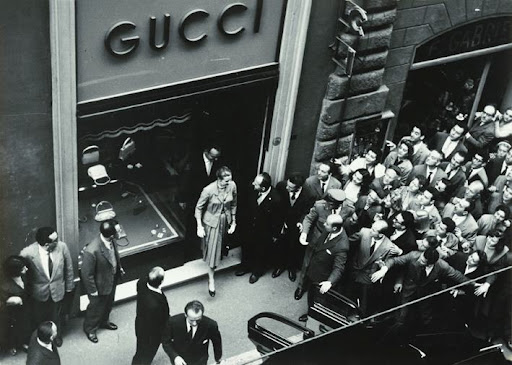The Story of Gucci

For almost a century, Italian fashion labels have been prominent among the finest luxury brands worldwide. Brands such as Versace, Prada, Armani, Gucci, and Dolce & Gabbana have had a lasting impact on the fashion world, and continue to do so. Perhaps the most acclaimed of these Italian fashion brands is Gucci. Guccio Gucci, the son of a humble leathergoods business owner, opened the very first Gucci store in Florence, Italy in 1921. His inspiration for the small luggage brand was sparked by London, and the aesthetic of English nobility. Guccio’s brand soon became acclaimed in Italy for its quality leathergoods and fine attention to detail. In 1953, the same year that Guccio Gucci passed away, Gucci’s first overseas store became a reality in New York City.
In just a little under a century, Gucci has thrived worldwide. Located in affluent locations such as Chicago, San Francisco, and Beverly Hills, there are over 30 Gucci flagship stores in the United States, and approximately 500 flagship stores worldwide. In the very beginning, Gucci was entirely centered around leather goods. The fashion label’s emergence in the clothing facet of the brand came from the creation of the iconic Gucci loafer that had a metal horsebit. To this date, the shoe still possesses an incredible amount of detailing and elegance, as it remains the only shoe in the permanent collection of the Metropolitan Museum of Art in New York. All of the original pairs adopted a North American moccasin style, and embodied a graceful touch as every pair was handcrafted to be as soft and lightweight as possible. This great representation of the brand’s integrity hasn’t withered over the years; every single pair of the classic loafers are still handmade to this date. While attaining much recognition for the brand’s production of stunning leather goods, as well as the elegant assembly of the Gucci loafers, the brand started to experiment with other garments and clothing pieces upon request. In synonymous timing, the brand started to become more and more famed in the United States. Perhaps the most prominent American to flaunt the brand at the time was John F. Kennedy’s wife, First Lady Jacqueline Kennedy. In the early 1960’s, the bag that first lady had been seen with almost daily, was renamed the “Jackie.” The First Lady was accompanied by another world-renowned woman, Princess of Monaco Grace Kelly, who made a personal request for a handcrafted scarf from the brand. As this scarf became increasingly sought after, the brand dubbed it the Fora Print Scarf.
Subsequent to the addition of stores located in Beverly Hills and Tokyo, the aspiring brand added another store just down the street from its very first American store on in New York in 1972. This new location focused on clothing, while its predecessor maintained a focus on shoes, bags, luggage and accessories. The fashion label surged into the forefront of the global fashion scene when Tom Ford, an American fashion designer, was appointed creative director in 1994. Ford released several collections, featuring a sleek modern style of the brand’s iconic look. The young American creator added many key personnel to the the label, including Frida Giannini, who had previously specialized as a handbag designer for Fendi. Ford and Gucci finally parted ways in 2004, when the pair couldn’t agree on contract terms. Ford left an insurmountable mark on the brand, as he worked with a plethora of others to continue to grow the brand. Soon after, Ford went on to establish his own fashion label, which attained much success.
In the years after the Ford era, Gucci opened a flagship store in Rome, began producing several unique men and women fragrances, relaunched the iconic Jackie bag, and even introduced a children’s line. In early 2015, Alessandro Michele took the reigns as creative director of Gucci. Prior to his surprising promotion at Gucci, the young Italian studied costume design at the Academy of Costume and Fashion in Rome. He then went on to establish himself at Fendi, focusing his efforts in leather goods in the late ‘90’s. Then creative director, Tom Ford, welcomed Michele to the company to design handbags. Since taking the new position in the brand, Michele has rejuvenated the renowned fashion label. Michele practically redefined what Gucci would represent, creating mismatched contemporary pieces that also accompany a vintage flow. In a conversation with Vogue’s Hamish Bowles, Alessandro Michele hinted at the perception of the brand he was trying to emit. He said, “I think we need to dream. So I wanted to present an idea of something romantic, in dream time-like in a movie.” The young creator also hinted at why Rome possesses a special influence in his creations. “There is something special about the culture of the fifties and the cinema,” he said of his hometown. “But I also need to travel. I need to go to London. You have everything there-present, past, future, exhibitions, and theatre.” Not only has Michele sought to spawn an immaculate level of originality in Gucci’s clothing, he has also created some of the most memorable set designs in the fashion industry.
As the fashion label continues to flourish, it pursues unique types of materials, consequently providing the most unique garments in the fashion world. According to a study by Business Insider, Gucci ranks as the fourth most successful luxury brand worldwide. Surpassed by its counterparts Louis Vuitton and Chanel, Gucci is valued at $12.7 billion. In its existence, the brand has made several audacious moves that have resulted in an immense amount of success. Many await in anticipation for what is to come from the brand, though it is very unpredictable. One thing is for sure: it will be amazing.

My name is Harrison Downard, an I was born in Evergreen, Colorado. Over the years, I’ve been heavily involved in my youth group at Central United Methodist...






